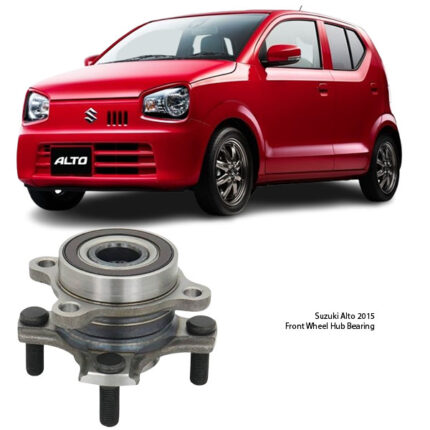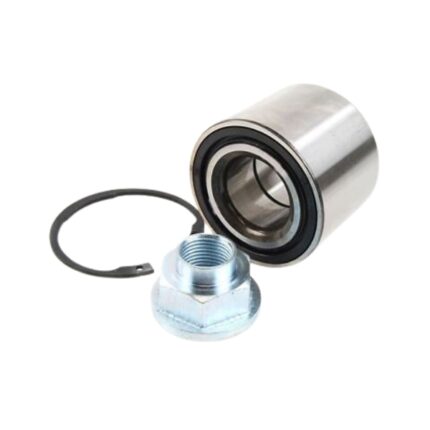Get Suzuki Alto Rear Wheel Bearing (KOYO) in Kenya
The rear wheel bearing is a vital component in a vehicle’s drivetrain and suspension system. It is engineered to enable the rear wheels to rotate smoothly while supporting the vehicle’s weight and maintaining proper alignment. While often overlooked, the rear wheel bearing plays a pivotal role in safety, handling, and overall driving comfort.
As vehicles continue to evolve in terms of speed, weight, and technological integration, wheel bearings have become more advanced in their construction and functionality. Today’s rear wheel bearings are precision-sealed units that offer durability, low rolling resistance, and compatibility with modern electronic systems such as ABS (Anti-lock Braking System) and ESC (Electronic Stability Control).
Core Functionality
The primary purpose of the rear wheel bearing is to:
-
Facilitate Wheel Rotation: It provides a low-friction interface between the rotating wheel hub and the stationary axle or suspension knuckle.
-
Support Vertical and Lateral Loads: It carries the vehicle’s weight as well as forces from braking, turning, and acceleration.
-
Ensure Wheel Alignment: It maintains the correct rotational axis of the wheel, ensuring precise tracking and stable handling.
-
Enhance Safety: When equipped with integrated sensors, it supports ABS and other stability systems by providing accurate wheel speed data.
A properly functioning rear wheel bearing helps ensure quiet operation, smooth wheel motion, and safe braking and cornering behavior.
Construction and Materials
Modern rear wheel bearings are manufactured using high-quality materials such as hardened chromium steel, which offers excellent wear resistance and strength. The bearing assembly typically consists of:
-
Outer Race (Outer Ring): Fixed within the wheel hub or knuckle.
-
Inner Race (Inner Ring): Connected to the axle shaft or stub shaft.
-
Rolling Elements: Either ball bearings (common in passenger cars) or tapered rollers (used in trucks and high-load applications).
-
Cage: Maintains even spacing between rolling elements and ensures uniform load distribution.
-
Seals: High-temperature rubber or metal-backed seals protect against moisture, dirt, and road contaminants.
-
Lubrication: Factory-sealed with high-performance grease for lifelong maintenance-free operation.
In some cases, the rear wheel bearing is integrated into a hub assembly, also referred to as a “hub bearing unit,” which includes a mounting flange, sensor ring, and sometimes a wheel speed sensor.
Types of Rear Wheel Bearings
Depending on the vehicle design and application, rear wheel bearings may fall into one of several categories:
-
Ball Bearings: Ideal for moderate radial and axial loads. Common in lighter vehicles.
-
Tapered Roller Bearings: Handle higher radial and thrust loads. Common in trucks, SUVs, and rear-wheel-drive platforms.
-
Double Row Angular Contact Bearings: Often used in sealed hub units, offering compact design with high load-carrying capability.
-
Hub Bearings with Sensor Rings: Feature magnetic encoders or tone rings to support electronic monitoring systems like ABS or TCS (Traction Control System).
Each type is tailored to specific performance, weight, and durability requirements.
Performance Characteristics
A high-quality rear wheel bearing is designed to perform under a variety of demanding conditions. Key performance attributes include:
-
Load Capacity: Must endure both vertical weight and lateral cornering forces.
-
Friction Reduction: Precision machining ensures minimal resistance and heat buildup during rotation.
-
Noise Suppression: Proper clearances and lubrication prevent rumbling, humming, or grinding noises.
-
Vibration Resistance: Maintains structural integrity during harsh driving conditions or rough terrain.
-
Thermal Stability: Designed to withstand the heat generated by brake systems and prolonged highway speeds.
-
Corrosion Resistance: Coated surfaces and high-quality seals resist moisture intrusion and chemical exposure.
A well-functioning bearing contributes significantly to vehicle longevity and driving satisfaction.
Signs of a Worn Rear Wheel Bearing
Over time, even the most durable rear wheel bearings will show signs of wear. Recognizing these symptoms early can prevent more extensive vehicle damage:
-
Grinding or Humming Noise: Especially noticeable at higher speeds or during turns.
-
Wheel Play or Looseness: Movement when the wheel is rocked by hand may indicate worn bearing races or rollers.
-
Vibration or Shuddering: Felt through the floorboard or steering wheel.
-
Uneven Tire Wear: Caused by wheel misalignment due to bearing failure.
-
ABS Warning Light: Triggered by a failed sensor or misaligned tone ring in sensor-equipped hubs.
-
Increased Rolling Resistance: A failing bearing may generate heat and reduce fuel efficiency.
Immediate replacement is recommended once these signs appear to avoid further drivetrain or suspension issues.
Installation and Fitment
Rear wheel bearing replacement varies in complexity depending on whether the vehicle uses a press-in bearing or a bolt-on hub assembly. Key steps include:
-
Vehicle Lift and Wheel Removal
-
Disconnection of Brakes and ABS Sensor (if applicable)
-
Hub or Bearing Extraction: May require hydraulic presses or specialty tools for press-fit designs.
-
Preparation of Mounting Surfaces: Clean and inspect for corrosion or damage.
-
Installation of New Bearing or Hub: Ensure correct torque settings and alignment.
-
Sensor Testing: For sensor-equipped units, check signal output using diagnostic tools.
Proper torque and alignment are crucial. Over-torquing can crush the bearing and cause premature failure, while under-torquing can allow excess movement.
Maintenance and Service Life
Modern rear wheel bearings are designed to be sealed for life, requiring no lubrication or adjustment under normal driving conditions. However, their longevity depends on factors such as:
-
Driving Habits: Aggressive driving or high-speed cornering may accelerate wear.
-
Load Conditions: Frequent heavy loads or towing increase bearing stress.
-
Environmental Exposure: Mud, road salt, and water can penetrate seals over time.
-
Installation Quality: Incorrect installation is a leading cause of premature bearing failure.
Under typical use, a rear wheel bearing can last between 100,000 to 160,000 kilometers, but performance may vary based on the above factors.
Advantages of a Quality Rear Wheel Bearing
-
Smooth and Quiet Operation
-
Improved Fuel Efficiency
-
Stable Handling and Cornering
-
Enhanced Braking Performance
-
Reduced Wear on Suspension and Tires
-
Compatibility with Modern Vehicle Safety Systems
Reliable wheel bearings also minimize vibration and noise, contributing to a more comfortable driving experience.
Follow us on Facebook for more parts.




